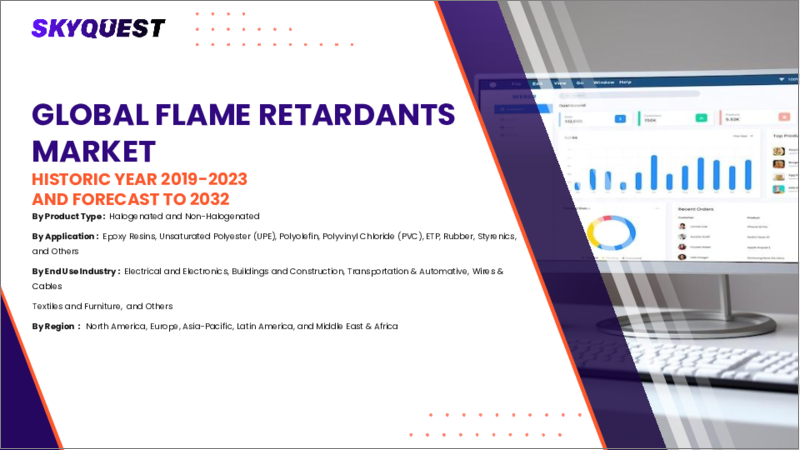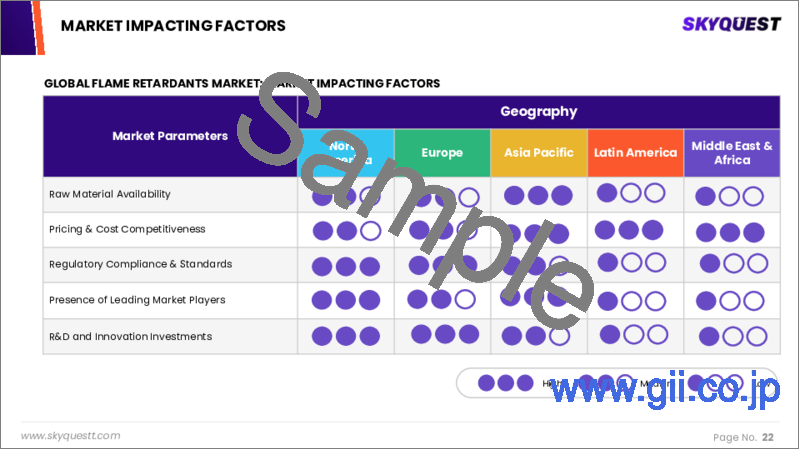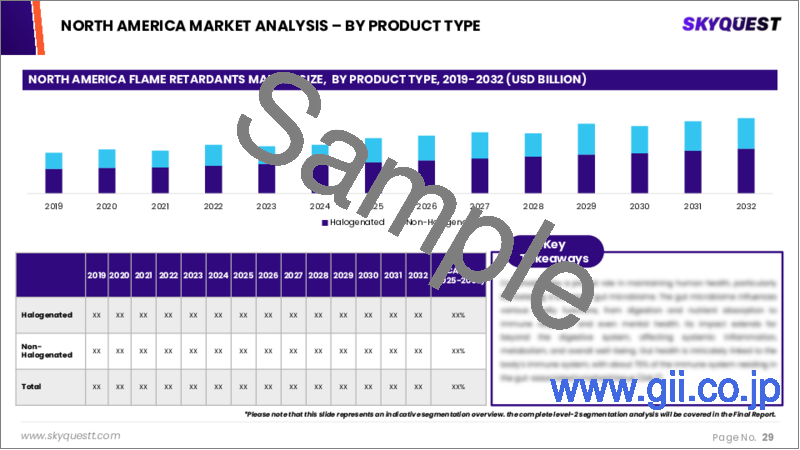|
|
市場調査レポート
商品コード
1603314
難燃剤の市場規模、シェア、成長分析、タイプ別、用途別、最終用途別、地域別 - 産業予測、2024年~2031年Flame Retardants Market Size, Share, Growth Analysis, By Type, By Application, By End-use By Region - Industry Forecast 2024-2031 |
||||||
|
|||||||
| 難燃剤の市場規模、シェア、成長分析、タイプ別、用途別、最終用途別、地域別 - 産業予測、2024年~2031年 |
|
出版日: 2024年11月27日
発行: SkyQuest
ページ情報: 英文 157 Pages
納期: 3~5営業日
|
全表示
- 概要
- 目次
難燃剤の世界市場規模は2022年に72億2,000万米ドルと評価され、予測期間(2024-2031年)のCAGRは5.1%で、2023年の75億9,000万米ドルから2031年には113億1,000万米ドルに成長する見通しです。
世界の難燃剤市場は、厳しい火災安全規制と火災の危険性に対する意識の高まりに後押しされ、着実な成長軌道に乗っています。産業界が難燃性材料を求めるようになり、消費者の火災安全に対する意識が市場の拡大をさらに後押ししています。特に発展途上地域で急成長している建設セクターは、建物の防火安全基準の強化に不可欠な難燃剤として、この成長において極めて重要な役割を果たしています。しかし、特に特定の化学難燃剤に関連する環境への影響や健康リスクにより、市場は大きな課題に直面しています。従来の製品には有毒物質が含まれていることが多く、環境問題や潜在的な健康被害が懸念されています。これに対し、業界は、性能を損なうことなく安全性を優先した、環境に優しい代替品に軸足を移しています。さらに、機械的強度や耐久性など、重要な材料特性と火災安全性要件のバランスをとることは、複雑な課題となっています。最終製品の全体的な完全性を確保しながら最適な耐火性を達成するには、業界内での継続的な技術革新と協力が必要です。性能要求を満たすと同時に、より安全で持続可能なソリューションを開発するという二重の焦点は、市場の将来の展望を形成する上で極めて重要です。
目次
イントロダクション
- 調査の目的
- 調査範囲
- 定義
調査手法
- 情報調達
- 二次データと一次データの方法
- 市場規模予測
- 市場の前提条件と制限
エグゼクティブサマリー
- 世界市場の見通し
- 供給と需要の動向分析
- セグメント別機会分析
市場力学と見通し
- 市場概要
- 市場規模
- 市場力学
- 促進要因と機会
- 抑制要因と課題
- ポーター分析と影響
- 競争企業間の敵対関係
- 代替品の脅威
- 買い手の交渉力
- 新規参入業者の脅威
- 供給企業の交渉力
主な市場の考察
- 重要成功要因
- 競合の程度
- 主な投資機会
- 市場エコシステム
- 技術の進歩
- 規制情勢
- バリューチェーン分析
- ケーススタディ分析
- 顧客と購買基準の分析
- PESTEL分析
- マクロ経済指標
- 市場の魅力指数
- 価格分析
難燃剤の市場規模:タイプ別& CAGR(2024-2031)
- アルミニウム三水和物
- 酸化アンチモン
- 臭素化難燃剤
- 塩素化難燃剤
- リン難燃剤
- 窒素難燃剤
- その他
- ホウ酸亜鉛
- 水酸化マグネシウム
- ホウ素難燃剤
難燃剤の市場規模:用途別& CAGR(2024-2031)
- エポキシ
- 不飽和ポリエステル
- ポリオレフィン
- ポリ塩化ビニル
- 腹筋とブレンド
- ポリスチレン
- ポリウレタン
難燃剤の市場規模:最終用途別& CAGR(2024-2031)
- 建築・建設
- 電子機器・家電製品
- 自動車・輸送
- ワイヤーとケーブル
- テキスタイル
- その他
難燃剤の市場規模:地域別& CAGR(2024-2031)
- 北米
- 米国
- カナダ
- 欧州
- 英国
- ドイツ
- スペイン
- フランス
- イタリア
- その他欧州地域
- アジア太平洋
- 中国
- インド
- 日本
- 韓国
- その他アジア太平洋地域
- ラテンアメリカ
- ブラジル
- その他ラテンアメリカ地域
- 中東およびアフリカ
- GCC諸国
- 南アフリカ
- その他中東・アフリカ
競合情報
- 上位5社の比較
- 主要企業の市場ポジショニング(2023年)
- 主な市場企業が採用した戦略
- 市場の最近の動向
- 企業の市場シェア分析(2023年)
- 主要企業の企業プロファイル
- 会社概要
- 製品ポートフォリオ分析
- セグメント別シェア分析
- 収益の前年比比較(2021-2023)
主要企業プロファイル
- Albemarle Corporation
- Clariant AG
- LANXESS AG
- BASF SE
- ICL Group Ltd.
- Nabaltec AG
- Huber Engineered Materials
- ADEKA Corporation
- Italmatch Chemicals S.p.A.
- Avient Corporation
- DSM-firmenich
- FRX Innovations
- DuPont
- THOR Group
- Lubrizol Corporation
結論と推奨事項
Global Flame Retardants Market size was valued at USD 7.22 billion in 2022 and is poised to grow from USD 7.59 billion in 2023 to USD 11.31 billion by 2031, at a CAGR of 5.1% during the forecast period (2024-2031).
The global flame retardants market is on a steady growth trajectory, propelled by stringent fire safety regulations and heightened awareness of fire hazards. As industries increasingly demand flame-resistant materials, consumer awareness regarding fire safety further fuels this market's expansion. The burgeoning construction sector, especially in developing regions, plays a pivotal role in this growth, as flame retardants are vital for enhancing fire safety standards in buildings. However, the market confronts significant challenges, particularly due to the environmental impact and health risks associated with certain chemical flame retardants. Traditional products often contain toxic substances, raising substantial environmental concerns and potential health hazards. In response, the industry is pivoting towards environmentally friendly alternatives that prioritize safety without compromising performance. Additionally, balancing fire safety requirements with essential material attributes, including mechanical strength and durability, presents a complex challenge. Achieving optimal fire resistance while ensuring the overall integrity of end products necessitates ongoing innovation and collaboration within the industry. This dual focus on developing safer, more sustainable solutions alongside meeting performance demands will be critical in shaping the market's future landscape.
Top-down and bottom-up approaches were used to estimate and validate the size of the Global Flame Retardants market and to estimate the size of various other dependent submarkets. The research methodology used to estimate the market size includes the following details: The key players in the market were identified through secondary research, and their market shares in the respective regions were determined through primary and secondary research. This entire procedure includes the study of the annual and financial reports of the top market players and extensive interviews for key insights from industry leaders such as CEOs, VPs, directors, and marketing executives. All percentage shares split, and breakdowns were determined using secondary sources and verified through Primary sources. All possible parameters that affect the markets covered in this research study have been accounted for, viewed in extensive detail, verified through primary research, and analyzed to get the final quantitative and qualitative data.
Global Flame Retardants Market Segmental Analysis
Global Flame Retardants Market is segmented by Type, by Application, by End Use and by Region. Based on Type, the market is segmented into Aluminium trihydrate, Antimony oxide, Brominated flame retardants, Chlorinated flame retardants, Phosphorus flame retardants, Nitrogen flame retardants, Others(zinc borate, magnesium hydroxide, boron flame retardants). Based on Application, the market is segmented into Epoxy, Unsaturated polyester , Polyolefin, Polyvinyl chloride , Abs & blends, Polystyrene, Polyurethane . Based on End Use, the market is segmented into Building & construction, Electronics & appliances, Automotive & transportation, Wires & cables, Textiles, Others. Based on region, the market is segmented into North America, Europe, Asia Pacific, Latin America and Middle East & and Africa.
Driver of the Global Flame Retardants Market
One of the primary drivers of the global flame retardants market is the enforcement of strict fire safety regulations by governments and regulatory authorities across the globe. These regulations require the incorporation of flame-retardant materials in numerous industries to improve fire safety and mitigate the likelihood of fire-related accidents. An increased emphasis on safeguarding public welfare and protecting property significantly fuels the demand for flame retardants. As these stringent standards continue to evolve and become more prevalent, industries are compelled to adopt flame-retardant solutions, driving growth within the market and ensuring safer environments for both individuals and assets.
Restraints in the Global Flame Retardants Market
The Global Flame Retardants market faces significant restraints due to environmental and health concerns linked to certain chemical compositions. Many traditional flame retardants, especially halogenated types, are known to release toxic byproducts during combustion or may present risks throughout their lifecycle, including manufacturing, usage, and disposal. These detrimental effects on health and the environment hinder market growth as regulatory scrutiny intensifies. Consequently, there is a growing demand for safer and more eco-friendly flame retardant alternatives, prompting stakeholders to prioritize sustainable development and innovation in order to mitigate risks and align with evolving consumer and regulatory expectations.
Market Trends of the Global Flame Retardants Market
The global flame retardants market is witnessing a significant trend towards the development of lightweight and high-performance solutions, driven by the burgeoning demand from key industries like automotive, aerospace, and electronics. As these sectors strive for enhanced safety measures while optimizing material weight, flame retardant manufacturers are innovating to produce advanced formulations that offer superior fire resistance without compromising on compliance with stringent industry standards. This shift not only addresses regulatory requirements but also aligns with the broader move towards fuel efficiency and sustainability, positioning lightweight flame retardants as critical components in the manufacturing of safer, more efficient products across various applications.
Table of Contents
Introduction
- Objectives of the Study
- Scope of the Report
- Definitions
Research Methodology
- Information Procurement
- Secondary & Primary Data Methods
- Market Size Estimation
- Market Assumptions & Limitations
Executive Summary
- Global Market Outlook
- Supply & Demand Trend Analysis
- Segmental Opportunity Analysis
Market Dynamics & Outlook
- Market Overview
- Market Size
- Market Dynamics
- Driver & Opportunities
- Restraints & Challenges
- Porters Analysis & Impact
- Competitive rivalry
- Threat of substitute
- Bargaining power of buyers
- Threat of new entrants
- Bargaining power of suppliers
Key Market Insights
- Key Success Factors
- Degree of Competition
- Top Investment Pockets
- Market Ecosystem
- Technological Advancement
- Regulatory Landscape
- Value Chain Analysis
- Case Study Analysis
- Customer & Buying Criteria Analysis
- PESTEL Analysis
- Macro-Economic Indicators
- Market Attractiveness Index
- Pricing Analysis
Global Flame Retardants Market Size by Type & CAGR (2024-2031)
- Aluminium trihydrate
- Antimony oxide
- Brominated flame retardants
- Chlorinated flame retardants
- Phosphorus flame retardants
- Nitrogen flame retardants
- Others
- Zinc borate
- Magnesium hydroxide
- Boron flame retardants
Global Flame Retardants Market Size by Application & CAGR (2024-2031)
- Epoxy
- Unsaturated polyester
- Polyolefin
- Polyvinyl chloride
- Abs & blends
- Polystyrene
- Polyurethane
Global Flame Retardants Market Size by End-use & CAGR (2024-2031)
- Building & construction
- Electronics & appliances
- Automotive & transportation
- Wires & cables
- Textiles
- Others
Global Flame Retardants Market Size by Region & CAGR (2024-2031)
- North America, (by Type, by Application, by End Use)
- US
- Canada
- Europe, (by Type, by Application, by End Use)
- UK
- Germany
- Spain
- France
- Italy
- Rest of Europe
- Asia-Pacific, (by Type, by Application, by End Use)
- China
- India
- Japan
- South Korea
- Rest of Asia Pacific
- Latin America, (by Type, by Application, by End Use)
- Brazil
- Rest of Latin America
- Middle East & Africa, (by Type, by Application, by End Use)
- GCC Countries
- South Africa
- Rest of Middle East & Africa
Competitive Intelligence
- Top 5 Player Comparison
- Market Positioning of Key Players, 2023
- Strategies Adopted by Key Market Players
- Recent Developments in the Market
- Company Market Share Analysis, 2023
- Company Profiles of All Key Players
- Company Details
- Product Portfolio Analysis
- Company's Segmental Share Analysis
- Revenue Y-O-Y Comparison (2021-2023)
Key Company Profiles
- Albemarle Corporation
- Company Overview
- Business Segment Overview
- Financial Updates
- Key Developments
- Clariant AG
- Company Overview
- Business Segment Overview
- Financial Updates
- Key Developments
- LANXESS AG
- Company Overview
- Business Segment Overview
- Financial Updates
- Key Developments
- BASF SE
- Company Overview
- Business Segment Overview
- Financial Updates
- Key Developments
- ICL Group Ltd.
- Company Overview
- Business Segment Overview
- Financial Updates
- Key Developments
- Nabaltec AG
- Company Overview
- Business Segment Overview
- Financial Updates
- Key Developments
- Huber Engineered Materials
- Company Overview
- Business Segment Overview
- Financial Updates
- Key Developments
- ADEKA Corporation
- Company Overview
- Business Segment Overview
- Financial Updates
- Key Developments
- Italmatch Chemicals S.p.A.
- Company Overview
- Business Segment Overview
- Financial Updates
- Key Developments
- Avient Corporation
- Company Overview
- Business Segment Overview
- Financial Updates
- Key Developments
- DSM-firmenich
- Company Overview
- Business Segment Overview
- Financial Updates
- Key Developments
- FRX Innovations
- Company Overview
- Business Segment Overview
- Financial Updates
- Key Developments
- DuPont
- Company Overview
- Business Segment Overview
- Financial Updates
- Key Developments
- THOR Group
- Company Overview
- Business Segment Overview
- Financial Updates
- Key Developments
- Lubrizol Corporation
- Company Overview
- Business Segment Overview
- Financial Updates
- Key Developments






